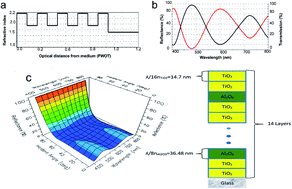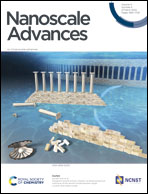Tailoring TiO2/Al2O3 heterolayers as optical filters for the visible region†
Abstract
Optical filters operating in the visible region of the spectrum are highly desired for applications ranging from optical communication and sensing to fluorescence microscopy and skin therapy. However, complex fabrication procedures and/or inferior performance, limit the practical applications of previously reported thin-film-based optical filters. Herein, we describe the structual design concepts and facile fabrication of vertically stacked heterolayers of TiO2/Al2O3 to obtain a bandpass filter and a longwave pass edge filter operating in the spectral range 410–600 nm and 400–597 nm, respectively. The optical filters are designed according to MacLeod simulation and fabricated via magnetron sputtering, depositing alternative stacks of low (Al2O3) and high (TiO2) refractive index materials with different thicknesses, as confirmed by spectroscopic ellipsometry. Owing to a reasonable matching between the design and the fabrication, our developed TiO2/Al2O3 heterolayer optical filters exhibited 54.60% transmission for 7-layer longwave pass edge filter and 15% reflectance for 14-layer bandpass filter of a selective set of wavelengths (400–800 nm).



 Please wait while we load your content...
Please wait while we load your content...